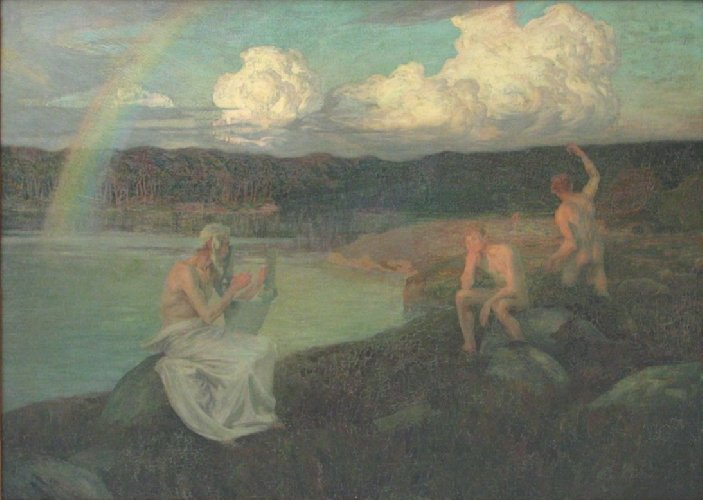Description:
Emile René Ménard (1862-1930) studied painting under Paul Baudry, then at the Académie Julian in Paris. He consistently exhibited at the Salon of the Société des Artistes Français from his debut in 1883. From 1891-1922 he participated in the Salons of the Société Nationale des Beaux-Arts. Inspired by his family’s fascination with Greek philosophy, he went on a journey through the lands of ancient Hellas, which had a great influence on his art. He mostly painted biblical and mythological scenes, as well as idealistic landscapes with a background of ancient architecture and athletic, nude figures.
Description of the painting:
Ménard turned to Greek philosophy by evoking the figure of Homer playing the lyre. Around him we can see silhouettes of men resembling ancient athletes against an idealistic landscape, not Greek but closer to his heart, his native French Brittany. The choice of this theme was related to the mood at the turn of the 19th / 20th centuries. In the age of rapidly developing civilization of factories, railroads and large industrial cities, there was a longing for an old, pure and unspoilt world. It was found, among others, in antiquity.
You can escape from the terrifying reality in various directions. Some of them lead us to the past, others to the future. The common denominator of them is the desire to find better worlds. For the artists of the turn of the 19th and 20th centuries, one of these “escape” places was the ideal, beautiful and harmonious world of ancient characters and themes.
Emile-René Ménard, painting “Homer”, remained faithful to his fascination with antiquity. He made contact with it still at home with two philosophers: his father and uncle. Following the passion implanted in him in his childhood, he went on a journey through the lands of ancient Hellas. He visited Greece, Sicily, Italy, and Palestine. He returned from this trip with numerous sketches, which he used and developed gradually in his painting. He was inspired by them, among others, when decorating parts of the Sorbonne.
On the presented painting we see Homer playing the lyre, in the background an idealistic landscape with a set of naked figures, two men with the silhouettes of ancient athletes. But let us pay attention to the fact that the presented scenery is not the views from ancient Greece but… even closer to the artist – Brittany. For the members of the “Black Band”, but also many other artists of this period, Brittany became the ideal land, unsullied, extolled like the Odyssey in Homer’s songs, which as chosen, one of the few could be saved from the chaos of the changing world.


